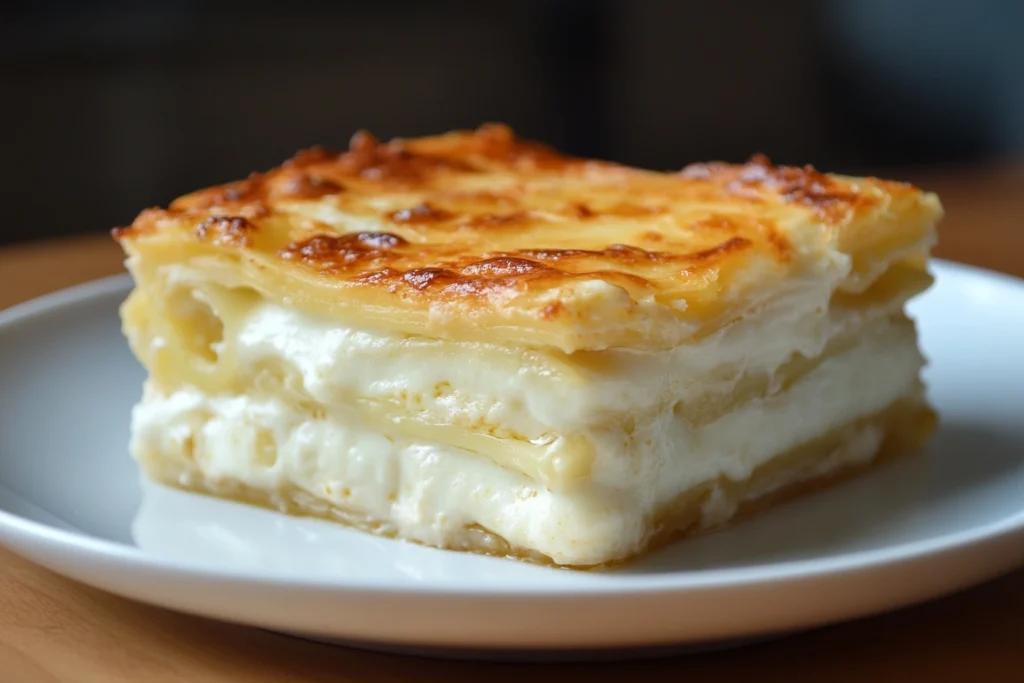White sauce is what you make when you want to impress but forgot to grocery shop. Got butter, flour, and milk? Boom—you’re a saucier now. Whether it’s for drowning veggies (so the kids will eat them), layering into lasagna like a culinary architect, or fixing that “oops, I overcooked the chicken” moment—this creamy lifesaver has your back. Stick around, and I’ll show you how to stir up magic with three pantry staples and a whisk that probably needs replacing.

Table of Contents
Step-by-Step Classic White Sauce Recipe
Print
White Sauce Recipe
- Total Time: 15 minutes
- Yield: 1.5 cups 1x
Description
A classic and creamy white sauce perfect for pasta, vegetables, or casseroles.
Ingredients
- 2 tablespoons butter
- 2 tablespoons all-purpose flour
- 2 cups milk
- Salt to taste
- Ground white or black pepper to taste
- Pinch of ground nutmeg (optional)
Instructions
- In a saucepan, melt the butter over medium heat.
- Add the flour and stir constantly for about 1-2 minutes until a paste forms, making sure it doesn’t brown.
- Gradually whisk in the milk, making sure there are no lumps.
- Continue stirring until the sauce thickens and becomes smooth.
- Season with salt, pepper, and a pinch of nutmeg if using.
- Use immediately or store in the fridge once cooled.
Notes
For a richer flavor, use whole milk. Keep stirring to avoid lumps and ensure smoothness.
- Prep Time: 5 minutes
- Cook Time: 10 minutes
- Category: Sauce
- Method: Stovetop
- Cuisine: International
Nutrition
- Serving Size: 2 tablespoons
- Calories: 80
- Sugar: 2g
- Sodium: 120mg
- Fat: 6g
- Saturated Fat: 3.5g
- Unsaturated Fat: 2.5g
- Trans Fat: 0g
- Carbohydrates: 5g
- Fiber: 0g
- Protein: 2g
- Cholesterol: 15mg
Keywords: white sauce, béchamel, creamy, base, easy sauce
Kitchen Tips for a Smooth, Lumpy-Free Texture

Even seasoned cooks sometimes struggle with lumps in white sauce. Here are a few tips to keep your sauce silky every time:
- Warm the milk: Cold milk added to a hot roux is a top reason sauces go lumpy.
- Whisk non-stop: Keep the whisk moving while adding milk and during the thickening stage.
- Strain if needed: If lumps still sneak in, pass the sauce through a fine mesh strainer before serving.
Looking for inspiration? Try our How to Make Delicious Chicken Parmesan recipe—it pairs beautifully with white sauce.
Troubleshooting Common White Sauce Problems

Why Is My White Sauce Too Thick or Runny?
Getting the perfect texture can be tricky. If your white sauce turns out more like paste or soup than a silky pour, don’t worry—it’s totally fixable.
| Problem | Cause | Fix |
|---|---|---|
| Too thick | Too much flour or too little milk | Whisk in warm milk a tablespoon at a time |
| Too thin | Not enough roux or over-thinning | Simmer longer or make a slurry with flour and water |
| Lumpy | Cold milk added too fast, or no whisking | Strain sauce or blend briefly |
| Gummy or sticky | Overcooked or overheated | Use gentle heat, stir constantly |
Pro Tip: Always start with a 1:1 butter-to-flour ratio. That’s the golden rule for a smooth, creamy roux.
Fixing Burnt, Bland, or Broken Sauce
Sometimes it’s not about texture—it’s the flavor (or lack of it). Here’s how to recover from the most common culinary curveballs:
Burnt Taste
If your roux smells scorched, don’t push forward. Start fresh. Burnt flour ruins the whole sauce and is nearly impossible to mask.
Bland Flavor
White sauce is meant to be neutral, but it should never be dull. Amp up flavor with:
- Salt and white pepper (white pepper blends seamlessly)
- Freshly grated nutmeg (a little goes a long way)
- Infused milk with garlic, bay leaf, or onion
Broken Sauce
If your sauce looks curdled or separated, you may have overheated the milk or added it too fast.
Fix: Take it off the heat and whisk in a splash of cold milk or cream to bring it back together.
Looking for inspiration? Try our Air Fryer Frozen Chicken Wings for a crispy contrast to your creamy white sauce—perfect balance in a meal.
Storage, Reheating, and Meal Prep Ideas

Best Ways to Store and Reheat White Sauce
Made too much sauce? That’s never a problem when you know how to store and reheat it properly. White sauce holds up well in the fridge and can be revived with just a little care.
Fridge Storage:
- Let the sauce cool completely
- Transfer to an airtight container
- Store in the fridge for up to 4 days
Freezer Storage:
- White sauce can be frozen, though it may separate slightly
- Cool it fully, then store in a freezer-safe container or bag
- Freeze for up to 2 months
- When thawing, stir gently over low heat to recombine any separation
Pro Tip: Label your containers with the date. Add a note like “For pasta or veggies!” to inspire quick meals.
Reheating White Sauce:
To reheat without clumping:
- Use low heat on the stovetop
- Stir constantly
- Add a splash of milk to loosen the texture
- Whisk to smooth it out
Avoid microwaving if possible—it can heat unevenly and cause the sauce to break.
White Sauce for Batch Cooking and Freezing
Meal preppers, rejoice! White sauce is a dream for prepping in advance. Make a double or triple batch and freeze it in portions.
Here are smart ways to use pre-made white sauce:
- Mix with shredded chicken and veggies for an instant pot pie filling
- Stir into cooked pasta, top with cheese, and bake for a creamy casserole
- Add to sautéed spinach or mushrooms for a quick creamed side
- Use in breakfast bakes or egg casseroles
It’s creamy, comforting, and customizable—exactly what your meal prep needs.
Learn more about creamy and comforting combos in our Simple Chocolate Cake—a great dessert follow-up to any white sauce-based dinner.
Wrap It Up and Whisk It Good
White sauce isn’t fancy—it’s your go-to move when dinner needs saving or comfort food calls. Now that you’ve got the know-how, don’t just read about it—get in the kitchen and stir something creamy! Try it on pasta, pour it over veggies, or build the ultimate lasagna.
Craving more saucy secrets? Bookmark this and share it with your favorite kitchen co-pilot.
FAQ
What is the mother of all white sauces?
The mother of all white sauces is the classic béchamel sauce. In French cuisine, it’s considered one of the five mother sauces, a foundational recipe from which other sauces (like Mornay, mustard, and cheese sauces) are created. It’s made with just three ingredients: butter, flour, and milk.
Is white sauce the same as Alfredo?
Nope—though both are creamy, white sauce and Alfredo are not the same. White sauce (béchamel) is made with a roux of flour and butter plus milk, while Alfredo relies on butter, cream, and Parmesan cheese.
What is white sauce made of?
At its core, white sauce is made of:
Butter (for richness)
Flour (to thicken)
Milk (for creaminess)
From there, it’s seasoned with salt, white pepper, and nutmeg. Some variations include cheese, cream, or aromatics like onion or bay leaf for added depth.
Want to branch out? Don’t miss our flavorful twist on sides with Delicious Chicken Parmesan or comforting Scalloped Potatoes.

